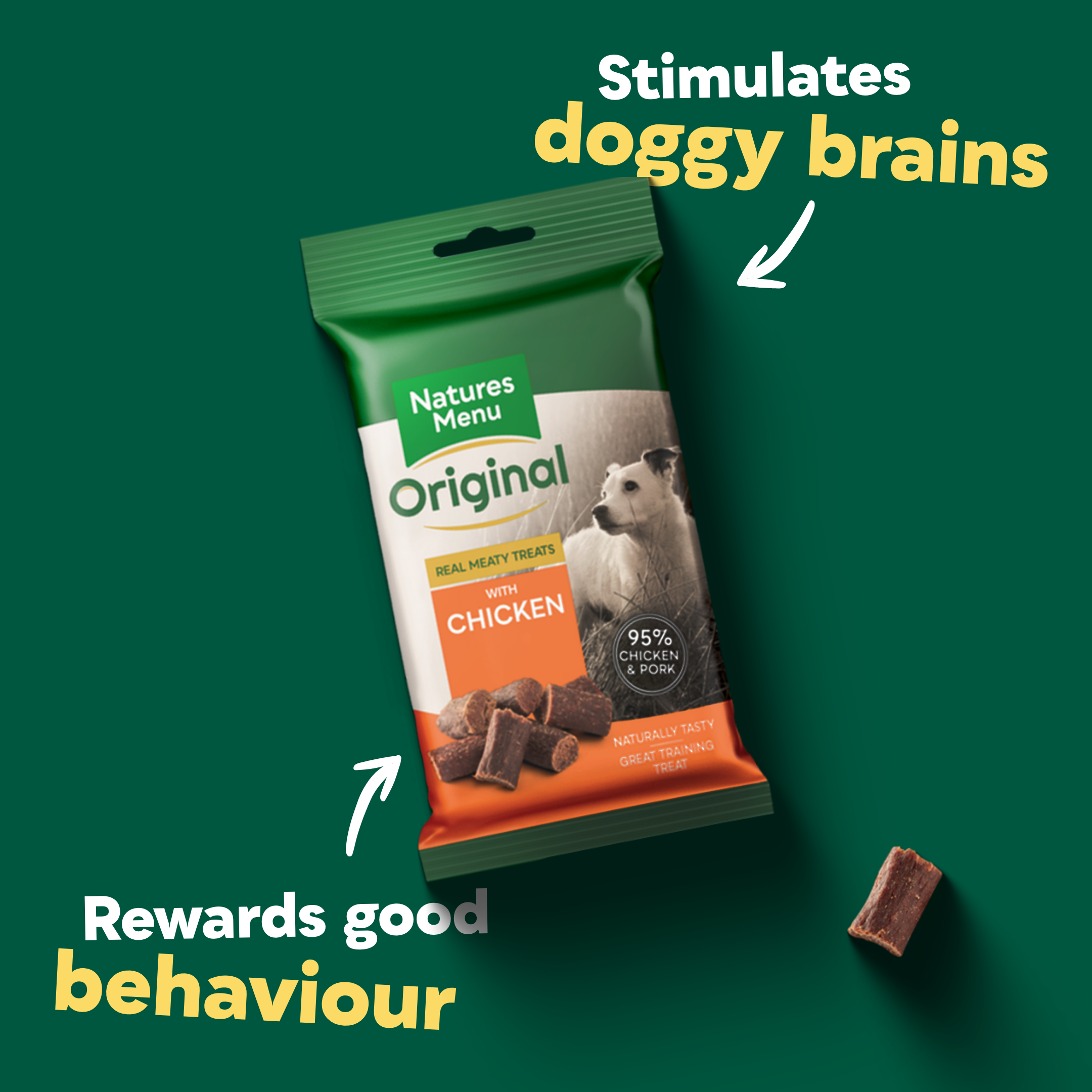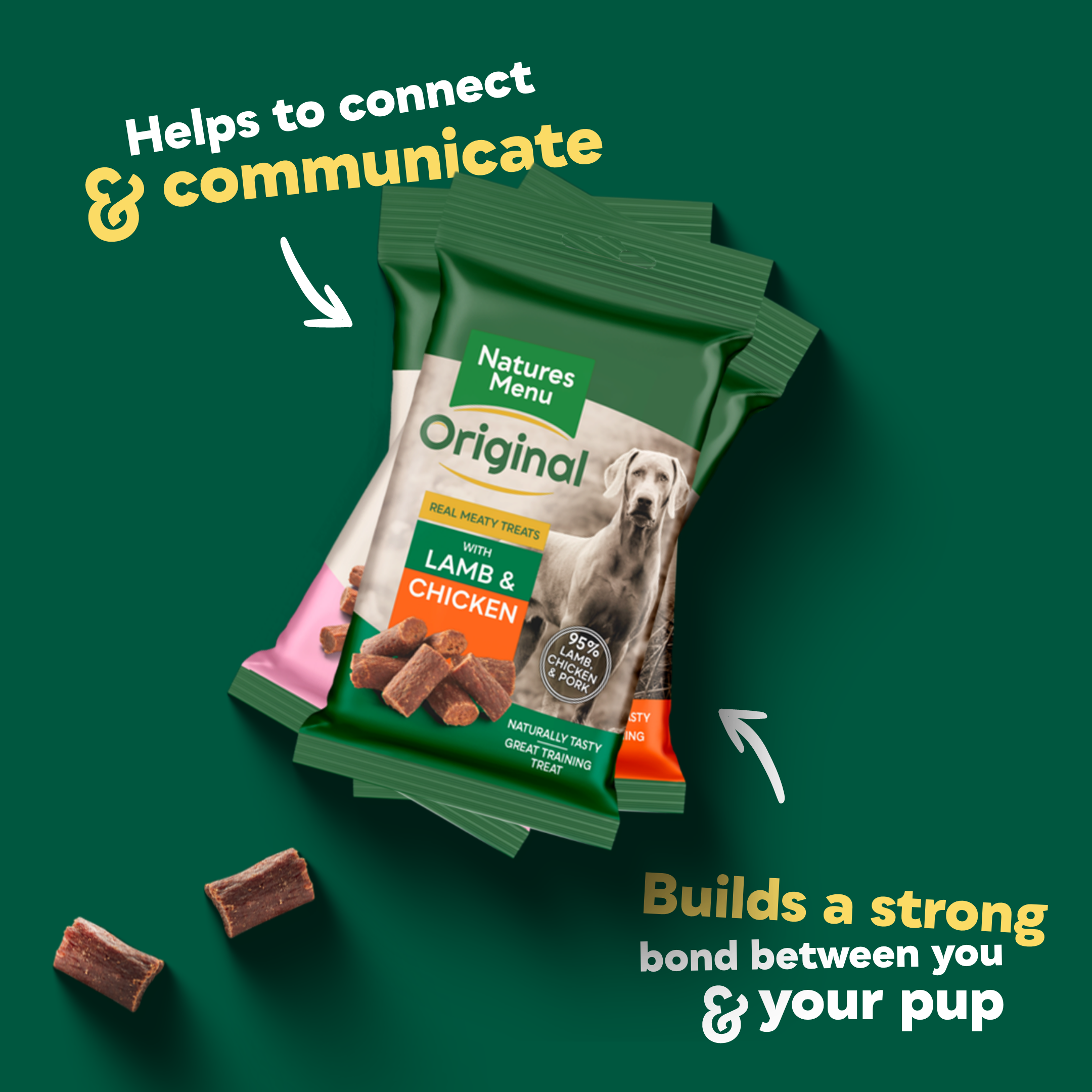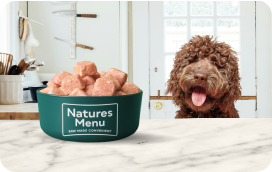WHY IT'S SO IMPORTANT TO GIVE YOUR DOGS HEALTHY TREATS
Table of Contents
Why are treats so important for dogs?
What makes a good dog treat?
Working out what your dog loves best
Healthy dog treats to try with your dog
Unhealthy dog treats it’s best to avoid
How many treats can dogs eat?
Using dog treats in the right way, at the right time
Your dog treat FAQs
- How often can I treat my dog?
- How many treats can I give my dog?
- What are healthy treats for dogs?
- What makes the perfect dog treat?
- Can dogs eat bones?
- What treats are dangerous for dogs?
To sum it all up…
Just like us, dogs love a good treat. Whether you’re giving tasty snacks, raw treats, toys or even cuddles, the right thing at the right time can be a great way to reward good behaviour. It also helps build a bond, and makes your four-legged friend happy. Which is why, in this blog we’re lifting the lid on dog treats. Let’s dive right in…
So, can dogs have bones? What treats shouldn’t dogs eat? And how many raw dog food treats is too many? We’ll be answering all the big questions and sharing our top tips on the best treats for your dog.
Why are treats so important for dogs?
For people, treats aren’t just about getting something nice. They’re about making the everyday more fun. They’re enjoyed together or are a reward to ourselves for working hard, and it’s just the same for dogs.
Treats are a quick, easy way to add extra enjoyment to your dog’s activities. They stimulate their minds and get their attention. This makes them really effective for reinforcing positive behaviour, and an essential part of dog training. Whether they’re treats to eat, or treats to play with, they can help you communicate with your four-legged friend. This connection builds a strong, happy relationship together.
What makes a good dog treat?
Don’t be tempted to give your dog your own treats. They’re notorious for scoffing all sorts of things, but biscuits, cakes and snacks made for people usually aren’t great for animals. Chocolate especially is poisonous for dogs. Save them for yourself, and pick something more pet friendly that will make their tummies a whole lot happier.
If you’re using treats for dog training, go for something soft, moist and smelly. This appeals to as many of their senses as possible. You’ll get the best results if you choose something with a high taste intensity that they’re not used to eating. Doing so gives them a real wow-factor reward. Stick to pea-sized pieces, so you can treat them each time they do the thing you’ve asked, really reinforcing that positive behaviour.
Don’t forget, different dogs love different things. While one might work hard for a particular snack, another might be indifferent. If they aren’t interested, they will be less responsive to what you’re asking. And remember: just because your dog will eat something doesn’t make it a treat. It needs to be something special, not everyday food. Think about your own treats – you might be happy to eat carrots, but you’d probably work harder for a cake.
 Working out what your dog loves best
Working out what your dog loves best
We really recommend treats for training. Start by finding out what your dog loves and save it for training times, so it’s extra special.
Not sure how to judge how much they’re enjoying something? Well, if they eat it, that’s obviously a start, but that doesn’t mean it’s a favourite. If they seem keen to get it, that’s better. Signs of interest might be wagging their tail, looking at you intently, or following you around while you get it out of the pack. But the real proof of how much they love a particular treat is what they’re prepared to do to get it.
Try to pick a few different treats you think they enjoy, then ask them to follow different commands. That way you can see how much work they’ll do to get even a tiny helping of each one. The idea is to build what’s called a treat hierarchy. That’s a top three (or so) of favourite treats, in the order that they’ll work hardest for. Then, whenever you’re training, you can save their absolute favourite treats for the trickiest tasks, or the things they’re most reluctant to do.
Healthy dog treats to try with your dog
Most dogs love big, meaty tastes, and there are plenty of dehydrated or freeze-dried options, like our Natures Menu Meaty Treats. You can take these with you on walks and use for on-the-go training and rewards. This type of treat gives your dog that intense hit of flavour we mentioned earlier. This stimulates their senses and helps you get – and hold – their attention.
If you’re wondering, can dogs eat bones? The answer is yes! Bones can be a great, long-lasting treat to reward your dog for a really good training session,or a tricky final task like a roll or prolonged wait. Just make sure dog bone treats are raw – cooked bones splinter easily and can be dangerous for your dog. We also recommend that your dog is already fed a raw diet and that you follow on-pack feeding advice to ascertain the best option for your pooch.
Can dogs have lamb bones and beef bones? Yes! All these are fine, and these raw dog food treats can also include raw chicken, duck or turkey wings.But to avoid choking or other issues, always keep an eye on your dog while they’re chewing bones, and go for bigger ones that they can’t fit in their mouth all in one go. There’s lots of advice on how to introduce them safely on the back of the packs so make sure you have a good read before making a purchase.
Yak milk dog treats and chew sticks for dogs, like bully sticks or rabbit ears, are another natural option that’s widely available and a great alternative to less-healthy rawhide. And if your dog doesn’t have any digestive issues, you could also try high-value rewards like sausage (make sure it doesn’t contain onion) or small amounts of cheese. With our own dogs, we’ve noticed squeezy cheese or liver paste tend to be firm favourites!
Of course, dog treats don’t have to be things they’ll eat. Toys make great rewards and playing with them together is a brilliant way of giving your dog the time and attention they love so much. Most dogs really enjoy a gentle game of tug with a favourite toy – just encourage them to keep all four paws on the floor.
Unhealthy dog treats it’s best to avoid
As we mentioned earlier, cooked bones can be dangerous for dogs. The cooking process makes them more likely to splinter, creating sharp edges that can cut your dog’s mouth and cause damage as they’re digested. So can dogs eat bones? Yes – but only if they’re raw treats and big enough not to be a choking hazard. And bone marrow dog treats are very rich, so a little goes a long way.
We also recommend avoiding rawhide. When dogs – especially smaller dogs – swallow pieces of it they find it hard to digest, and it often contains high levels of artificial and chemical ingredients. In fact, anything overly artificial is best avoided, and anything tasteless will be far less effective as a treat. That’s why raw dog treats are some of the best for your dog.
While a few dry treats are fine, don’t give your dog too many as they’ll quickly get thirsty and potentially lose concentration.
How many treats can dogs eat?
Most dogs will eat as many treats as they can get their paws on. But that’s not great for them, and definitely won’t help with their training. Try to save treats for when you want to reward and build good behaviour. Don’t overdo it – if they’re constantly eating that favourite snack, it’ll soon become less motivating.
As a guideline, ideally no more than 5% of your dog’s daily calorie intake should come from snacks. But exact quantities will depend on what the treat is, how big a portion you’re giving them, and what size dog they are. Good quality treats will always have an approximate feeding guide on the back of the pack, and if it suggests no more than 5 pieces per day, try breaking those 5 pieces into smaller ones so treat time lasts longer!. We’d recommend using small, bite-sized treats when you’re training, and keeping sizes consistent so they know what to expect. If you’re suddenly giving them a much smaller helping, don’t be surprised if they’re not quite so keen to do what you ask!
 Using dog treats in the right way, at the right time
Using dog treats in the right way, at the right time
Treats are a super effective way of communicating with your dog. They help you show them what kind of behaviour you want to see. This helps build safe, healthy habits that keep you, your dog and your whole family happy. So it’s worth being really conscious about when you treat your dog, and what message that’s giving them.
When they behave well, whether you’ve asked them to or not, that’s a good time to treat your dog. This is especially true if they’ve had to go against their instincts or master something they used to find really difficult, like staying calm, or sitting and waiting. A treat shows you’re pleased and encourages them to do the same next time. Just be careful if they’ve been doing heavy exercise – you want your dog to enjoy their treat, not inhale it!
Your dog treat FAQs
How often can I treat my dog?
You can treat your dog whenever they behave well, but try to keep portions small and remember treats should only make up around 5% of their daily calorie intake.
How many treats can I give my dog?
Stick to one at a time, so your dog sees their treats as something special that they’re prepared to work hard for. If you give too many, too often, they’ll soon become less valuable and interesting.
What are healthy treats for dogs?
Treats with a high meat content, like our Meaty Treats, are healthy, natural and give your dog the intense flavours they’re looking for. You could also try raw bones or, for something less meaty, yak milk chews, or chew sticks for dogs.
What makes the perfect dog treat?
The perfect dog treat is something soft and moist, with an intense flavour and smell that stimulates your dog’s senses. Use pea-sized pieces, and avoid artificial ingredients, too many dry treats or human snacks.
Can dogs eat bones?
Yes, but only if they’re raw. They can have lamb and beef bones, and chicken, turkey and duck wings. Always keep an eye on your dog while they’re chewing a bone, just in case. Make sure they’re big enough to not be a choking hazard and follow the instructions on the packet.
What treats are dangerous for dogs?
Cooked bones are dangerous for dogs because they can splinter and cut their mouths or insides, while particularly hard bones can break or chip their teeth if not fed correctly, and rawhide can be difficult to digest. Chocolate and some fruits and veggies can also be dangerous – you’ll find a full list of what to avoid right here.
To sum it all up…
Treats are really important for training and communicating with your dog. The more thought you put into what to give, and when to give it, the better the results. Take the time to find out your dog’s favourites, be consistent about when they deserve a treat, and enjoy making them happy when they do!








 Working out what your dog loves best
Working out what your dog loves best Using dog treats in the right way, at the right time
Using dog treats in the right way, at the right time